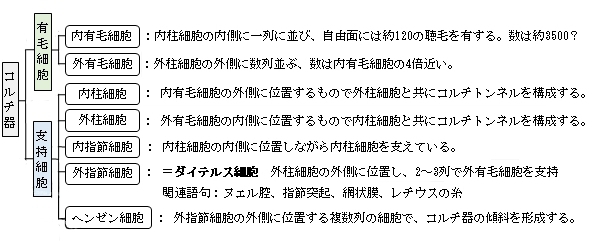
【以下のような特徴を有する】
・自由面(蓋膜に向かう面)には約120本の聴毛(感覚毛)が生じる。
・「感覚毛は微絨毛(不動毛)で、ラセン器の感覚細胞には線毛は見られない。」 (日本人体解剖学)
・基底面(基底板に向かう面)は内指節細胞に支えられ基底板には達していない。

|
|
|
|
|
コルチ器 |
コルチ器(除蓋膜) |
蝸牛管 |
蝸牛ラセン管 |
|
以下は「Wikipedia」の解説文となる。
The deflection of the hair-cell stereocilia opens mechanically gated ion channels that allow any small, positively charged ions (primarily potassium and calcium) to enter the cell. Unlike many other electrically active cells, the hair cell itself does not fire an action potential. Instead, the influx of positive ions from the endolymph in the scala media depolarizes the cell, resulting in a receptor potential. This receptor potential opens voltage gated calcium channels; calcium ions then enter the cell and trigger the release of neurotransmitters at the basal end of the cell. The neurotransmitters diffuse across the narrow space between the hair cell and a nerve terminal, where they then bind to receptors and thus trigger action potentials in the nerve. In this way, the mechanical sound signal is converted into an electrical nerve signal. Repolarization of hair cells is done in a special manner. The perilymph in the scala tympani has a very low concentration of positive ions. The electrochemical gradient makes the positive ions flow through channels to the perilymph.
【 語 句 】
・deflection:変節、離脱 ・stereocilis:不動毛 ・ion channel:イオンチャンネル ・potassium:カリウム ・calcium:カルシウム ・action potential:活動電位 ・influx:流入 ・endolymph:内リンパ ・scala media:中心階 ・depolarize:分極化を排除する ・receptor potential:受容器電位 ・voltage gated calcium channel:電位開口型カルシウムチャンネル ・neurotransmitter:神経伝達物質 ・diffuse:放散する ・repolarization:再分極 ・perilymph: ・scala tympani: ・electrochemical gradient:電気化学的勾配
Hair cells chronically leak Ca2+. This leakage causes a tonic release of neurotransmitter to the synapses. It is thought that this tonic release is what allows the hair cells to respond so quickly in response to mechanical stimuli. The quickness of the hair cell response may also be due to the fact that it can increase the amount of neurotransmitter release in response to a change of as little as 100 μV in membrane potential.
Hair cells are also able to distinguish tones through one of two methods. The first method uses electrical resonance in the basolateral membrane of the hair cell. The electrical resonance for this method appears as a damped oscillation of membrane potential responding to an applied current pulse.
The second method uses tonotopic differences of the basilar membrane. This difference comes from the different locations of the hair cells. Hair cells that have high-frequency resonance are located at the basal end while hair cells that have significantly lower frequency resonance are found at the apical end of the epithelium.
【 語 句 】
・chronically:慢性的に ・tonic release:緊張開放? ・: ・: ・basolateral membrane:足底膜 ・resonance:反響、共振 ・damped:振動を抑える? ・oscillation:振動、振幅 ・tonotopic:周波数特定性の ・apical:頂上の ・epithelium:上皮
■ 写真やイラストを掲載しているサイト ■
・ イラストや写真を掲載しているサイト-Ⅰ
・ イラストや写真を掲載しているサイト-Ⅱ
・ イラストや写真を掲載しているサイト-Ⅲ
・ イラストや写真を掲載しているサイト-Ⅳ(内・外)
・ イラストや写真を掲載しているサイト-Ⅴ
